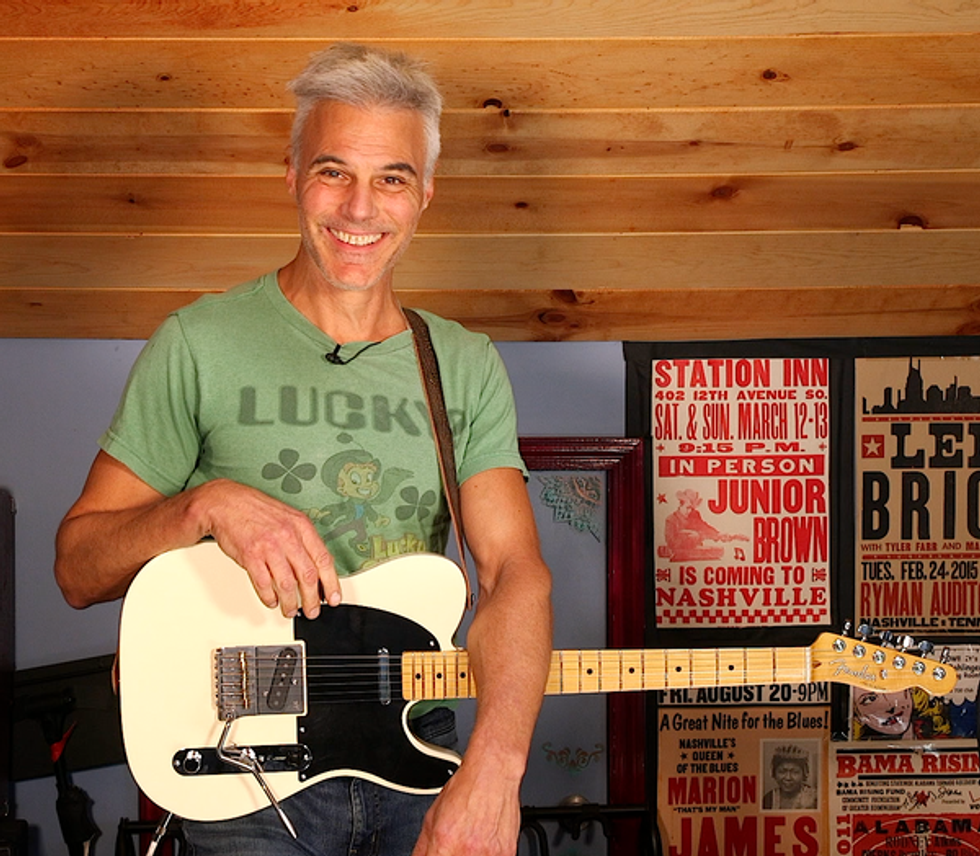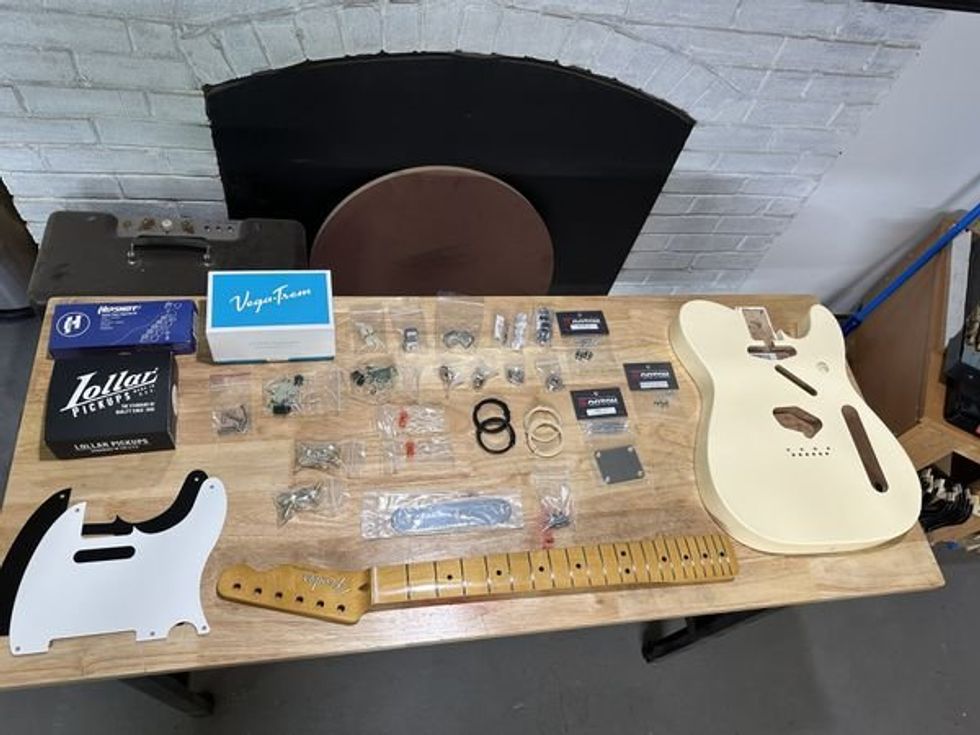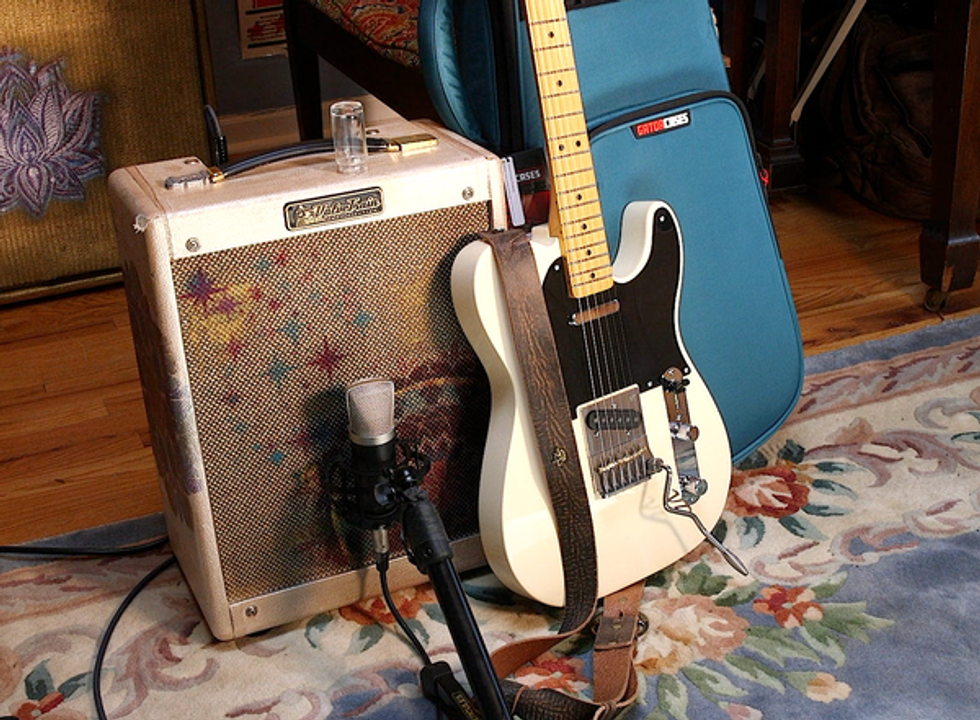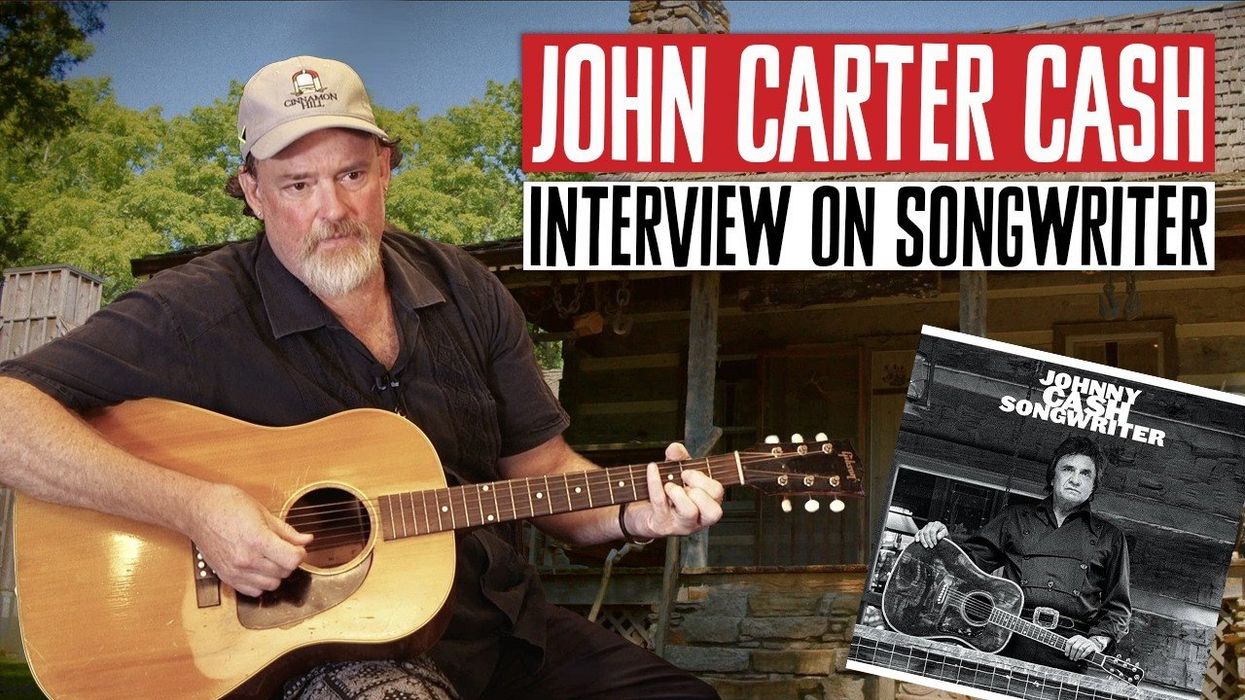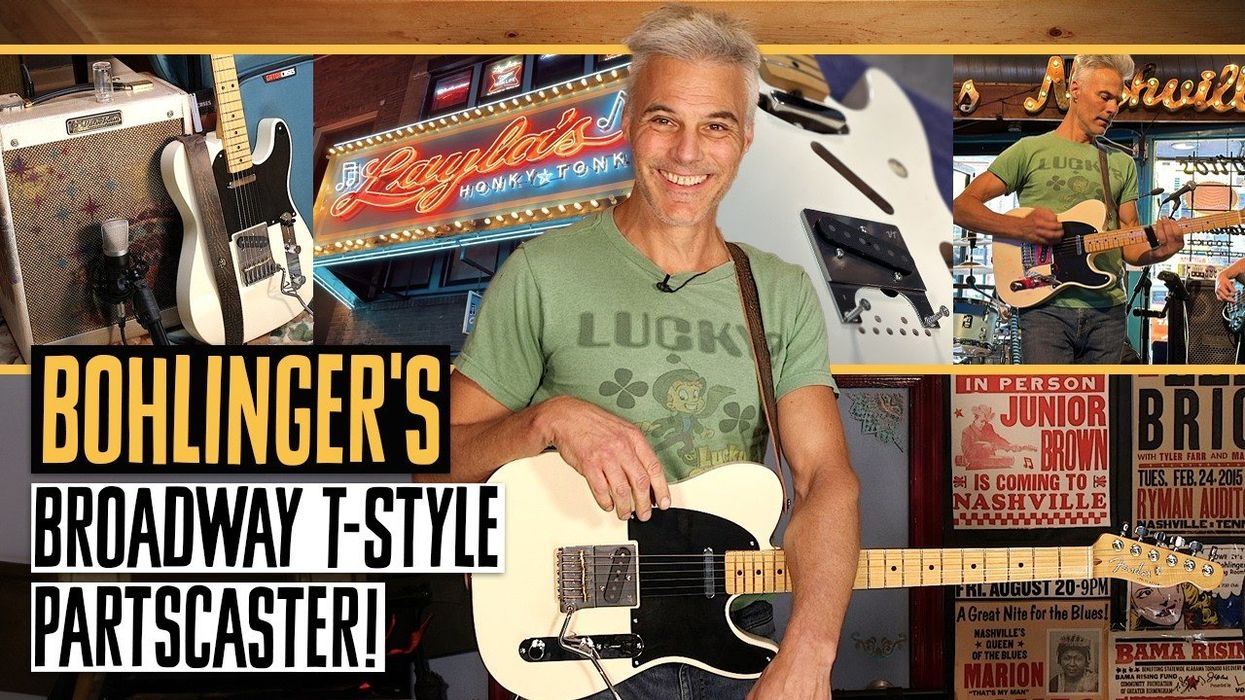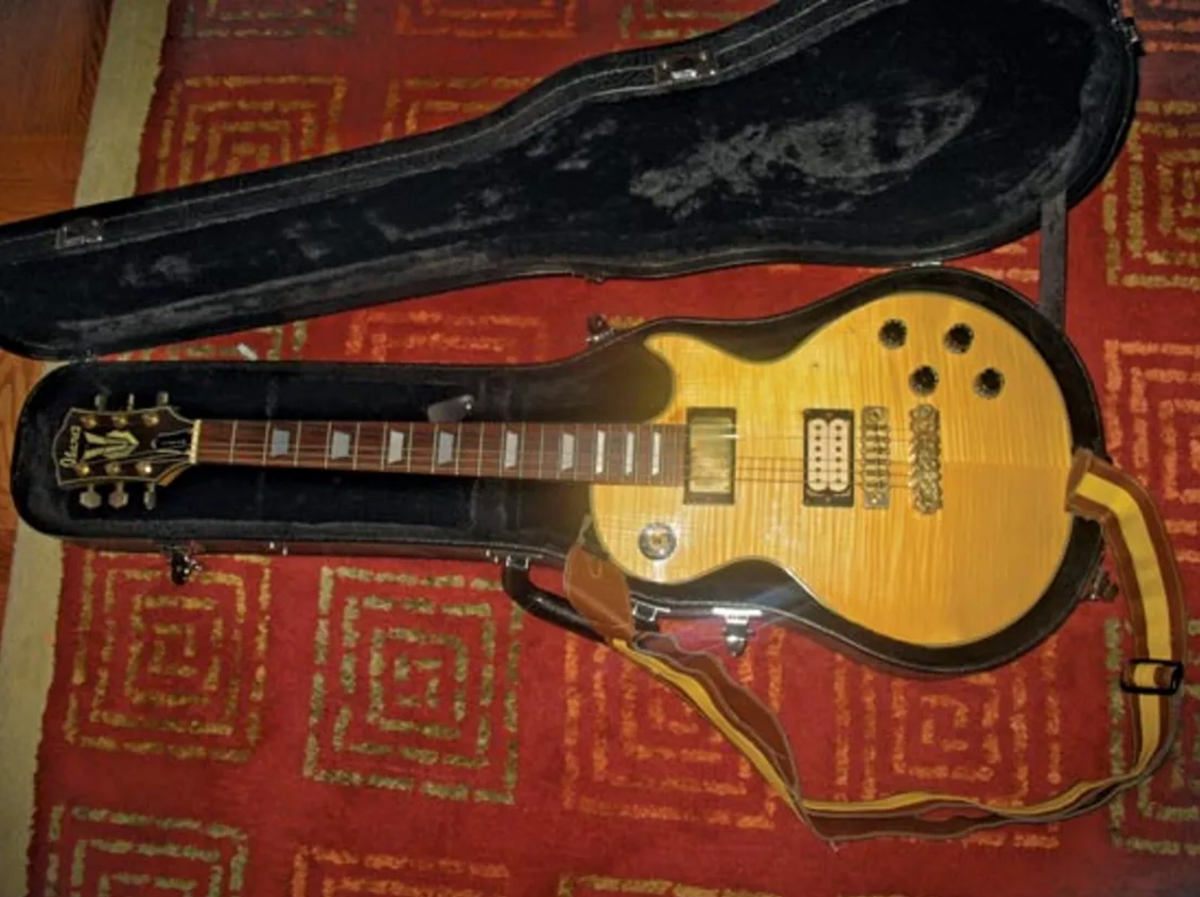
The story behind Ibanez-lawsuit era guitars, and how much this Les Paul-style is worth.
Hey Zach, I have owned this Ibanez "lawsuit" guitar for over 25 years and I'd like to know a little more about it. The serial number on the neck plate is K7709XX and as far as I know, it is all original except for the missing pickup cover. Can you tell me more about Ibanez's lawsuit guitars and how much this is worth today?
Thanks,
Chris Natale — NYC
Many Japanese-copied "lawsuit era" guitars under names like Greco, Aria, Tokai, and Ibanez have taken on an almost cult-like status today among many guitar collectors. While most readers understand what a "lawsuit era" guitar refers to, others may not and I'll try to summarize the term.
In the early 1970s, American guitar manufacturers (particularly Gibson, Fender, and Martin) were experiencing a steady decline in production quality while more Japanese- built guitars were showing up in the American market. By the mid-'70s, these Japanese guitars consisted of mostly blatant copies of popular American designs and the quality was much better than people wanted to admit. In 1977, Gibson sued the Elger Company (the distributor of Ibanez instruments in the U.S. at the time) and demanded they stop producing copies of their instruments, specifically their headstocks. Japanese-built guitars that are copies of American designs before the Gibson lawsuit are commonly referred to as "lawsuit era" guitars today.
Ibanez was certainly guilty of copying Gibson, Fender, and Martin models, among others, but they were also one of the most proactive companies when it came to introducing original designs. Between 1975 and 1977, Ibanez introduced several original designs including the popular Iceman and the Artist Series. In fact, by 1977 when Elger signed an agreement to stop building copies, their entire line consisted of almost all original instruments anyway.
Your guitar appears to be a Les Paul Custom copy that Ibanez labeled Model 2391. According to the serial number, it was built in November 1977, which is considered a transitional period. The Gibson/Elger lawsuit was filed on June 28, 1977, and was resolved not too long after. By September 1977, Ibanez was ready with their entire new line of instruments and copies were essentially a thing of the past. However, there was a transitional period where models were still produced with both copied and original designs. Your guitar clearly has a Les Paul body shape, but it has Ibanez's original headstock design, a large adjustable bridge, and an elaborate tailpiece, which are all original Ibanez designs.
The Model 2391 was loosely based on a Les Paul Custom and featured a mahogany body, maple top, and clear "See-Thru" finish. Just like a Les Paul Custom, this guitar has multiply body and headstock binding, fancy headstock pearl inlays (another Ibanez original design), and a "Custom" truss rod cover. However, the most notable difference between this guitar and a real Gibson is the bolt-on neck. The pickguard has been removed, as well as the bridge pickup cover. The volume and tone knobs have rubber inserts around them for a better grip, which Ibanez called Sure-Grip knobs. There is some belt buckle wear on the back along with some hardware oxidation, but overall the guitar appears to be in excellent condition.
Based on the condition and missing original parts, your Ibanez Model 2391 is worth between $475 and $550 today. If this guitar was in mint condition with all original parts in place, it would be worth between $600 and $700. In comparison, a mid-'70s Les Paul Custom is currently worth between $2500 and $3000. The Model 2391 probably retailed between $300 and $400 originally while the Gibson Les Paul retailed for between $850 and $950 in 1978. Other Ibanez Les Paul Custom-based guitars include the Model 2335, Model 2341, Model 2350, Model 2386, Model 2393, and Model 2398.
The question many of you may be asking is why the disparity in value between a real Les Paul Custom and a copy if the quality is comparable? No question, there is a lot of value in a name and Gibson is the most valuable name in the guitar world. Bolt-on neck guitars are usually considered inferior to set necks, which also attributes to a lesser value on the copy. For most copy, budget, and value instruments from the 1960s and 1970s, I've noticed that they raise and lower in value proportionally to vintage and collectible instruments, which is the case for this Ibanez.
Copies of American guitars propelled Ibanez as a guitar company in the 1970s, but Ibanez really established their own trademark with unique designs, a commitment to quality, and their relationships with artists. While not very expensive, I challenge you to find an Ibanez that isn't a treasure!
Source: Ibanez, The Untold Story by Paul Specht, Michael Wright, Jim Donahue, and Pat Lefferts.
[Updated 10/29/21]
The Man in Black returns with the unreleased Songwriter album. John Carter Cash tells us the story.
“The Man Comes Around” is a much-played song from the final album Johnny Cash recorded before his death in 2003, American IV: The Man Comes Around. Now, the Man in Black himself has come around again, as the voice and soul of an album he initially cut in 1993, titled Songwriter. It hits the street on June 28.
For fans who know Cash only through his much-loved American Recordings series, this is a very different artist—healthy, vital, his signature baritone booming, his acoustic playing lively, percussive, and focused. This is the muscular Johnny Cash heard on his career-defining recordings, from his early Sun Records sides like “Cry! Cry! Cry!” and “Folsom Prison Blues” to “Ring of Fire” and “Sunday Mornin’ Comin’ Down” to later, less familiar hits like “The Baron” and “That Old Wheel.” In short, classic Cash—the performer who became an international icon and remains one even 21 years after his death.
I recently visited the Cash Cabin recording studio—a log cabin on the Cash family property in Hendersonville, Tennessee, that was originally built as a sanctuary where Johnny wrote songs and poetry—with PG’s video team of Chris Kies and Perry Bean to talk about Songwriter with John Carter Cash, the son of Johnny and June Carter Cash.
In addition to getting the lowdown on Songwriter from John Carter Cash, he showed us some of the iconic guitars—including original Johnny Cash lead guitarist Luther Perkin’s 1953 Fender Esquire and a Martin that was favored by the Man himself—that dwell at the busy private studio. Check out this visit.
Jesse Dayton uses an EP-3, from the first generation of solid-state Echoplex models, on the road and in the studio.
From Page to Eddie to Gilmour, the comparatively impractical Maestro Echoplex has nonetheless served its masters well. And for some, like our 6-stringing contributor, it still does.
Feast your eyes on the missing link. I give you the coolest contraption to ever run between a guitar and an amplifier: the Maestro Echoplex.
The cool factor for this historic piece of gear is so off the chart that I’m always a bit shocked when players, young or old, are not familiar with this marvelous old-school tape-echo device. But no, I’m not writing this to copy and paste Wikipedia stats on this crown jewel of the guitar-pedal world. (However, if your inner nerdom is anything like mine, it’s worthy of a snoop. All of the Echoplexes from 1959 to the late ’70s sound amazing!) I’m writing to profess to all my fellow guitar gear freaks my undying love for something that was used on so many historical recordings that it’s mind-blowing. And while a big box with an analog tape loop might not be your idea of a great ride-along pal on tour, or even in the studio, truth is, there is nothing else exactly like an authentic Echoplex.
Do you remember the first time you heard that huge swelling repeat sound at the end of “Eruption” by Van Halen? Echoplex. How about the heaviness of Jimmy Page’s guitar on “Moby Dick” by Led Zeppelin? That’s a cranked Echoplex preamp, mis amigos!
The Echoplex design is pretty simple, which is one reason why it’s so iconic. It has actual tape that runs on the top of the unit, records your sound, then plays it back. Remember 8-track tape players? Yeah, kind of like that—except for the recording part. You just crank the slide in the middle—at least on the solid-state EP-3 model that I own—to make the delay effect go fast or slow. It’s not rocket science. But it does also work as a preamp and will enhance the tone of the guitar coming out of your amp like no other unit. Eric Johnson, for example, travels with one in a rack, sans tape, just so he can use the preamp for his classic tone. The Echoplex preamp basically boosts and compresses your signal, fattening it up and providing some EQ trickery that will have guitar players unfamiliar with the device’s charms scratching their heads.
The original Echoplexes come in four flavors: the EP-1, EP-2, EP-3, and EP-4. The EP-1 is the O.G.—the first tape delay ever, with a moving tape head that allows the delay time to be changed. It was made from ’59 to ’62, when the next generation of ’Plex, called the EP-2, not only gave the tape head more mobility but protected the tape itself in a cartridge. The solid-state version was the EP-3, which was used by Van Halen, Page, Tommy Bolin, and Brian May, among others. The EP-4 offered an output buffer to improve impedance-matching with other gear. Today, you can find early generation Echoplexes for anywhere from $1,400 to nearly $2,000, and the EP-3 and EP-4 are in the $600 to $1,500 range, depending on condition.
“I have all kinds of analog delay pedals but none of them compare to the Echoplex.”
There are related devices out there that some vintage-tone-inclined players, like Brian Setzer, prefer. The Roland Space Echo is one, and there’s the Binson Echorec. They’re easier for traveling because the Space Echo has a more efficient tape transport system and the Binson records on a drum rather than a length of tape. David Gilmour from Pink Floyd was a fan of the Echorec. But just remember, it is the original Echoplex sound those models were built to emulate. And both of those artists also used original Echoplex units on a few of their classic recordings.
Sure, you can buy some newfangled digital pedal that tries to recreate the Echoplex, but what fun is there in that? Where’s the potential for tape snarls or the manual cleaning required? After owning several EP-3 Echoplexes and using them in recording studios on countless tracks, touring all over the world with one in cars, vans, RVs, buses, and planes, I can tell you nothing replicates or enhances your tone like an EP-3. And if you do roll out with one, don’t forget Q-tips and a bottle of rubbing alcohol to clean the tape heads when they get dirty. If that doesn’t sound like a good time, then I guess you don't wanna get the sound that fattened up the guitars in power trios like Joe Walsh’s James Gang or on Billy Gibbons’ first five ZZ Top albums.
I have all kinds of analog delay pedals but none of them compare to the Echoplex. Remember, a cool thing about owning vintage gear is not that it’s a piece of handcrafted history, but knowing that Leo Fender or Les Paul himself, or, in this case, Echoplex designer Mike Battle, is never making another one like the one that you own. Don't get overwhelmed or anxious by projecting what could go wrong with it. Get excited about having a piece of gear that can make your guitar sound like almost every classic-rock, blues, and country record ever made.Guest picker Mei Semones joins reader Jin J X and PGstaff in delving into the backgrounds behind their picking styles.
Question: What picking style have you devoted yourself to the most, and why does it work for you?
Guest Picker - Mei Semones

Mei’s latest album, Kabutomushi.
A: The picking style I’ve practiced the most is alternate picking, but the picking style I usually end up using is economy picking. Alternate feels like a dependable way to achieve evenness when practicing scales and arpeggios, but when really playing, it doesn’t make sense to articulate every note in that way, and obviously it’s not always the fastest.
Obsession: My current music-related obsession is my guitar, my PRS McCarty 594 Hollowbody II. I think it will always be an obsession for me. It’s so comfortable and light, has a lovely, warm, dynamic tone, and helps me play faster and cleaner. This guitar feels like my best friend and soulmate.
Reader of the Month - Jin J X
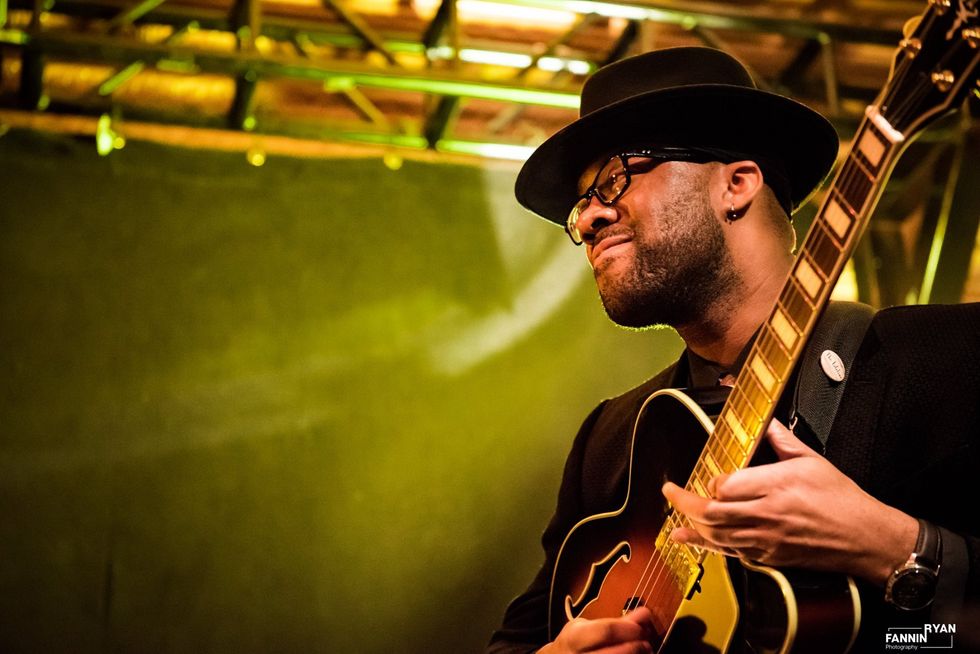
Photo by Ryan Fannin
A: For decades, the Eric Johnson-style “hybrid picking” with a Jazz III for “pianistic” voicings. Great for electric, though not so much acoustic. I’ve been recently learning to use a flatpick, à la Brian Sutton, by driving the pick “into” the string at an angle—which makes me think of Pat Metheny and George Benson, without irony.
Obsession: I’m still focused on understanding the concepts of jazz, neo-classical, and beyond, though I’m also becoming obsessed with George Van Eps’ 7-string playing, flatpicking, hip-hop beats, the Hybrid Guitars Universal 6 guitar, and the secret life of the banjo.
Editorial Director - Ted Drozdowski

A: Decades ago, under the sway of Mississippi blues artists R.L. Burnside, Junior Kimbrough, and Jessie Mae Hemphill, I switched from plectrum to fingerstyle, developing my own non-traditional approach. It’s technically wrong, but watching R.L., in particular, freestyle, I learned there is no such thing as wrong if it works.
Obsession: Busting out of my songwriting patterns. With my band Coyote Motel, and earlier groups, I’ve always encouraged my talented bandmates to play what they want in context, but brought in complete, mapped-out songs. Now, I’m bringing in sketches and we’re jamming and hammering out the arrangements and melodies together. It takes more time, but feels rewarding and fun, and is opening new territory for me.
Managing Editor - Kate Koenig

A: I have always been drawn to fingerpicking on acoustic guitar, starting with classical music and prog-rock pieces (“Mood for a Day” by Steve Howe), and moving on to ’70s baroque-folk styles, basic Travis picking, and songs like “Back to the Old House” by the Smiths. I love the intricacy of those styles, and the challenge of learning to play different rhythms across different fingers at the same time. This is definitely influenced by my classical training on piano, which came before guitar.
Obsession: Writing and producing my fifth and sixth albums. My fifth album, Creature Comforts, was recorded over the past couple months, and features a bunch of songs I wrote in 2022 that I had previously sworn to never record or release. Turns out, upon revisiting, they’re not half bad! While that one’s being wrapped, I’m trying to get music written for my sixth, for which I already have four songs done. And yes, this is a flex. 💪😎
After the success of wiring up the dream stomp station for gigging in Music City, PG's video crew work with Scale Model Guitars' luthier Dave Johnson to construct a T-style partscaster with parts from StewMac, Lollar, Gotoh, VegaTrem, Hipshot, Gator, Art of Tone, and others. And afterwards John Bohlinger takes downtown to Layla's to test it out
Bohlinger's Tele-Style Partscaster!
